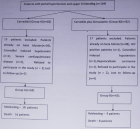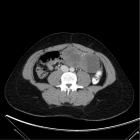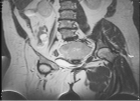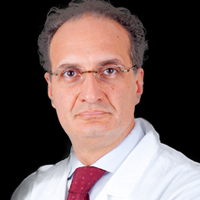Abstract
Review Article
Microbiome and Gastroesophageal Disease: Pathogenesis and Implications for Therapy
Steve M D’Souza*, Lindsey B Cundra, Byung Soo Yoo, Parth J Parekh and David A Johnson
Published: 21 May, 2020 | Volume 4 - Issue 1 | Pages: 020-033
There is growing evidence that gastroesophageal disease is influenced by the esophageal microbiome, and that commensal bacteria of the oropharynx, stomach, and colon are thought to have a role in modulatiing pathogenesis. These emerging hypotheses are based on observed changes in the composition of the esophageal flora, notably, repeated observations: 1. There is an abundance of gram-positive bBacteria in the healthy esophagus. are more gram positive prevalent 2. The esophageal bacterial population becomes increasingly gram negative with disease progression. Associated with this shift to a more gram negative prevalence is an increase in the potential for the presence of antigenic lipopolysaccharide (LPS). The immunoreactivity of LPS endotoxin thought to promote susceptibility to inflammation and disease.
The pathogenesis of the more common diseases of the esophagus e.g. gastroesophageal reflux disease (GERD), esophageal dysmotility (achalasia), eosinophilic esophagitis (EoE), Barrett’s esophagus (BE), and esophageal cancer, are well-established. Emerging data suggest however, that these are all characterized by an immune-mediated inflammatory cascade, propogated by a dysbiotic state. Thereby, the ability of the healthy “normative state” to protect against foreign bacteria is compromised. This dysbiosis thereby can create adverse inflammatory or immunoregulatory responses with progression of disease.
In the normal healthy state, the esophageal microbiome is constituted in-part, by a multitude of gram positive bacteria, many of which produce antibacterial peptides called bacteriocins. Bacteriocins are selective and used to maintain population integrity by killing off foreign bacteria. When the “normative biome” is interrupted (e.g. antibiotics, medications, diet, environmental factors), the constitutional changes may allow a more hospitable imbalance favoring the proliferation of opportunistic pathogens. Therefore it seems rational that defining, perhaps that defining, perhaps cultivating, a protective bacterial community that could help prevent or mitigate inflammatory diseases of the esophagus. Furthermore, in conjunction with evidence demonstrating that some bacteriocins are cytotoxic or antiproliferative toward cancer cell lines, further exploration might provide a rich source of effective peptide-based drug targets.
Therapeutic options targeting the microbiome, including prebiotics, probiotics, antibiotics and bacteriocins, have been studied, albeit the attributable effects on the esophagus for the most part, have been unrecognized by clinicians. This review focuses on the current knowledge of the involvement of the microbiome in esophageal diseases (most notably GERD/Barrett’s esophagus/esophageal cancer) and identifies emerging new concepts for treatment.
Read Full Article HTML DOI: 10.29328/journal.acgh.1001018 Cite this Article Read Full Article PDF
Keywords:
Microbiome; GERD; Probiotics; Prebiotics; Bacteriocins; Dysbiosis; Barrett’s esophagus; Esophageal cancer; Esophagitis; Eosinophilic esophagitis
References
- Peery AF, Crockett SD, Murphy CC, Lund JL, Dellon ES, et al. Burden and Cost of Gastrointestinal, Liver, and Pancreatic Diseases in the United States: Update 2018. Gastroenterology. 2019;156: 254-272.e11. PubMed: https://pubmed.ncbi.nlm.nih.gov/30315778/
- Almario CV, Ballal ML, Chey WD, Nordstrom C, Khanna D, et al. Burden of Gastrointestinal Symptoms in the United States: Results of a Nationally Representative Survey of Over 71,000 Americans. Am J Gastroenterol. 2018;113: 1701-1710. PubMed: https://www.ncbi.nlm.nih.gov/pmc/articles/PMC6453579/
- Hayeck TJ, Kong CY, Spechler SJ, Gazelle GS, Hur C. The prevalence of Barrett’s esophagus in the US: estimates from a simulation model confirmed by SEER data. Dis esophagus Off J Int Soc Dis Esophagus. 2010;23: 451-457. PubMed: https://www.ncbi.nlm.nih.gov/pmc/articles/PMC2896446/
- Siegel RL, Miller KD, Jemal A. Cancer statistics, 2020. CA Cancer J Clin. 2020; 70: 7-30. PubMed: https://www.ncbi.nlm.nih.gov/pubmed/31912902
- Carding S, Verbeke K, Vipond DT, Corfe BM, Owen LJ. Dysbiosis of the gut microbiota in disease. Microb Ecol Heal Dis. 2015; 26. PubMed: https://www.ncbi.nlm.nih.gov/pubmed/25651997
- Yang L, Lu X, Nossa CW, Francois F, Peek RM, Pei Z. Inflammation and Intestinal Metaplasia of the Distal Esophagus Are Associated With Alterations in the Microbiome. Gastroenterology. 2009;137: 588-597. PubMed: https://www.ncbi.nlm.nih.gov/pmc/articles/PMC2963147/
- Ajayi TA, Cantrell S, Spann A, Garman KS. Barrett’s esophagus and esophageal cancer: Links to microbes and the microbiome. PLoS Pathog. 2018;14: e1007384. PubMed: https://www.ncbi.nlm.nih.gov/pubmed/30571768
- Deshpande NP, Riordan SM, Castaño-Rodríguez N, Wilkins MR, Kaakoush NO. Signatures within the esophageal microbiome are associated with host genetics, age, and disease. Microbiome. 2018;6. PubMed: https://www.ncbi.nlm.nih.gov/pubmed/30558669
- Bassis CM, Erb-Downward JR, Dickson RP, et al. Analysis of the upper respiratory tract microbiotas as the source of the lung and gastric microbiotas in healthy individuals. MBio. 2015; 6.
- Orlando RC. The integrity of the esophageal mucosa. Balance between offensive and defensive mechanisms. Best Pract Res Clin Gastroenterol. 2010 ;24: 873-882. PubMed: https://www.ncbi.nlm.nih.gov/pubmed/21126700
- Katz PO, Gerson LB, Vela MF. Guidelines for the diagnosis and management of gastroesophageal reflux disease. Am J Gastroenterol. 2013;108: 308-328. PubMed: https://www.ncbi.nlm.nih.gov/pubmed/23419381
- Mazgaeen L, Gurung P. Recent Advances in Lipopolysaccharide Recognition Systems. Int J Mol Sci. 2020; 21: 379. PubMed: https://www.ncbi.nlm.nih.gov/pubmed/31936182
- Souza RF, Huo X, Mittal V, Schuler CM, Carmack SW, et al. Gastroesophageal Reflux Might Cause Esophagitis Through a Cytokine-Mediated Mechanism Rather Than Caustic Acid Injury. Gastroenterology. 2009;137: 1776-1784. PubMed: https://pubmed.ncbi.nlm.nih.gov/19660463/
- Dunbar KB, Agoston AT, Odze RD, et al. Association of acute gastroesophageal reflux disease with esophageal histologic changes. JAMA - J Am Med Assoc. 2016; 315: 2104-2112. PubMed: https://www.ncbi.nlm.nih.gov/pubmed/27187303
- Harnett KM, Rieder F, Behar J, Biancani P. Viewpoints on Acid-Induced Inflammatory Mediators in Esophageal Mucosa. J Neurogastroenterol Motil. 2010; 16: 374-388. PubMed: https://www.ncbi.nlm.nih.gov/pubmed/21103419
- Nikaki K, Sawada A, Ustaoglu A, Sifrim D. Neuronal Control of Esophageal Peristalsis and Its Role in Esophageal Disease. Curr Gastroenterol Rep. 2019; 21: 1-9. PubMed: https://www.ncbi.nlm.nih.gov/pubmed/31760496
- Huo X, Zhang X, Yu C, et al. In oesophageal squamous cells exposed to acidic bile salt medium, omeprazole inhibits IL-8 expression through effects on nuclear factor-κB and activator protein-1. Gut. 2014;63: 1042-1052. PubMed: https://www.ncbi.nlm.nih.gov/pmc/articles/PMC3959621/
- Sweet MJ, Hume DA. Endotoxin signal transduction in macrophages. J Leukoc Biol. 1996; 60: 8-26. PubMed: https://www.ncbi.nlm.nih.gov/pubmed/8699127
- Liaunardy-Jopeace A, Gay NJ. Molecular and cellular regulation of Toll-like receptor-4 activity induced by lipopolysaccharide ligands. Front Immunol. 2014; 5: 473. PubMed: https://www.ncbi.nlm.nih.gov/pubmed/25339952
- Kany S, Vollrath JT, Relja B. Cytokines in inflammatory disease. Int J Mol Sci. 2019; 20: 6008. PubMed: https://www.ncbi.nlm.nih.gov/pmc/articles/PMC6929211/
- Lewis AJ, Seymour CW, Rosengart MR. Current Murine Models of Sepsis. Surg Infect (Larchmt). 2016; 17: 385-393. PubMed: https://www.ncbi.nlm.nih.gov/pmc/articles/PMC4960474/
- Fonseca SG, Romão PRT, Figueiredo F, Morais RH, Lima HC, et al. TNF-α mediates the induction of nitric oxide synthase in macrophages but not in neutrophils in experimental cutaneous leishmaniasis. Eur J Immunol. 2003; 33: 2297-2306. PubMed: https://www.ncbi.nlm.nih.gov/pubmed/12884305
- Salim T, Sershen CL, May EE. Investigating the role of TNF-α and IFN-γ activation on the dynamics of iNOS gene expression in lps stimulated macrophages. PLoS One. 2016; 1: e0153289. PubMed: https://www.ncbi.nlm.nih.gov/pmc/articles/PMC4898755/
- Sharma JN, Al-Omran A, Parvathy SS. Role of nitric oxide in inflammatory diseases. Inflammopharmacology. 2007;15: 252-259. PubMed: https://www.ncbi.nlm.nih.gov/pubmed/18236016
- Cauwels A, Bultinck J, De Zwaef R, Vandendriessche B, Magez S, et al. Nitric oxide production by endotoxin preparations in TLR4-deficient mice. Nitric Oxide - Biol Chem. 2014; 36: 36-43. PubMed: https://www.ncbi.nlm.nih.gov/pubmed/24269486
- Yang L, Francois F, Pei Z. Molecular pathways: Pathogenesis and clinical implications of microbiome alteration in esophagitis and barrett esophagus. Clin Cancer Res. 2012;18: 2138-2144. PubMed: https://www.ncbi.nlm.nih.gov/pubmed/22344232
- Blackett KL, Siddhi SS, Cleary S, et al. Oesophageal bacterial biofilm changes in gastro-oesophageal reflux disease, Barrett’s and oesophageal carcinoma: Association or causality? Aliment Pharmacol Ther. 2013; 37: 1084-1092. PubMed: https://www.ncbi.nlm.nih.gov/pubmed/23600758
- Liu F, Ma R, Wang Y, Zhang L. The clinical importance of campylobacter concisus and other human hosted Campylobacter species. Front Cell Infect Microbiol. 2018; 8: 243. PubMed: https://www.ncbi.nlm.nih.gov/pubmed/30087857
- Corning B, Copland AP, Frye JW. The Esophageal Microbiome in Health and Disease. Curr Gastroenterol Rep. 2018; 20: 39. PubMed: https://www.ncbi.nlm.nih.gov/pubmed/30069679
- Nadell CD, Ricaurte D, Yan J, Drescher K, Bassler BL. Flow environment and matrix structure interact to determine spatial competition in Pseudomonas aeruginosa biofilms. Elife. 2017; 6: e21855. PubMed: https://www.ncbi.nlm.nih.gov/pubmed/28084994
- Marsh PD. Dental plaque as a biofilm and a microbial community - implications for health and disease. BMC Oral Health. 2006; 6 (Suppl 1): S14. PubMed: https://bmcoralhealth.biomedcentral.com/articles/10.1186/1472-6831-6-S1-S14
- Dejea CM, Fathi P, Craig JM, et al. Patients with familial adenomatous polyposis harbor colonic biofilms containing tumorigenic bacteria. Science. 2018; 359: 592-597. PubMed: https://www.ncbi.nlm.nih.gov/pubmed/29420293
- Lebeaux D, Ghigo JM, Beloin C. Biofilm-Related Infections: Bridging the Gap between Clinical Management and Fundamental Aspects of Recalcitrance toward Antibiotics. Microbiol Mol Biol Rev. 2014; 78: 510-543. PubMed: https://www.ncbi.nlm.nih.gov/pubmed/25184564
- Imhann F, Bonder MJ, Vila AV, et al. Proton pump inhibitors affect the gut microbiome. Gut. 2016 ;65: 740-748. PubMed: https://www.ncbi.nlm.nih.gov/pubmed/26657899
- Jackson MA, Goodrich JK, Maxan ME, et al. Proton pump inhibitors alter the composition of the gut microbiota. Gut. 2016; 65: 749-756. PubMed: https://www.ncbi.nlm.nih.gov/pubmed/26719299
- Macke L, Schulz C, Koletzko L, Malfertheiner P. Systematic review: the effects of proton pump inhibitors on the microbiome of the digestive tract—evidence from next-generation sequencing studies. Aliment Pharmacol Ther. 2020;51: 505-526. PubMed: https://www.ncbi.nlm.nih.gov/pubmed/31990420
- Janarthanan S, Ditah I, Adler DG, Ehrinpreis MN. Clostridium difficile-associated diarrhea and proton pump inhibitor therapy: A meta-analysis. Am J Gastroenterol. 2012; 107: 1001-1010. PubMed: https://www.ncbi.nlm.nih.gov/pubmed/22710578
- Uno Y. GERD by colonic fermentation. Neurogastroenterol Motil. 2020; 32.
- Piche T, Des Varannes SB, Sacher-Huvelin S, Holst JJ, Cuber JC, et al. Colonic fermentation influences lower esophageal sphincter function in gastroesophageal reflux disease. Gastroenterology. 2003; 124: 894-902. PubMed: https://www.ncbi.nlm.nih.gov/pubmed/12671885
- Ropert A, Cherbut C, Roze C, et al. Colonic fermentation and proximal gastric tone in humans. Gastroenterology. 1996; 111: 289-296. PubMed: https://www.ncbi.nlm.nih.gov/pubmed/8690193
- Larraufie P, Martin-Gallausiaux C, Lapaque N, et al. SCFAs strongly stimulate PYY production in human enteroendocrine cells. Sci Rep. 2018; 8.
- Hurst NR, Kendig DM, Murthy KS, Grider JR. The short chain fatty acids, butyrate and propionate, have differential effects on the motility of the guinea pig colon. 2014; 26: 1586-1596. PubMed: https://www.ncbi.nlm.nih.gov/pubmed/25223619
- Shaheen NJ, Falk GW, Iyer PG, Gerson LB. ACG Clinical Guideline: Diagnosis and Management of Barrett’s Esophagus. Am J Gastroenterol. 2016;111: 30-50. PubMed: https://www.ncbi.nlm.nih.gov/pubmed/27356842
- Naini BV, Souza RF, Odze RD. Barrett’s esophagus: A comprehensive and contemporary review for pathologists. Am J Surg Pathol. 2016;40: e45-e66. PubMed: https://www.ncbi.nlm.nih.gov/pmc/articles/PMC4833583/
- Pei ZH, Yang L, Peek RM, Levine SM, Pride DT, et al. Bacterial biota in reflux esophagitis and Barrett’s esophagus. World J Gastroenterol. 2005; 11: 7277-7283. PubMed: https://www.ncbi.nlm.nih.gov/pmc/articles/PMC3025696/
- Quante M, Bhagat G, Abrams JA, et al. Bile acid and inflammation activate gastric cardia stem cells in a mouse model of barrett-like metaplasia. Cancer Cell. 2012; 21: 36-51. PubMed: https://www.ncbi.nlm.nih.gov/pubmed/22264787
- Münch NS, Fang HY, Ingermann J, Maurer hc, Anand a, et al. High-Fat Diet Accelerates Carcinogenesis in a Mouse Model of Barrett’s Esophagus via Interleukin 8 and Alterations to the Gut Microbiome. Gastroenterology. 2019; 157: 492-506.e2. PubMed: https://pubmed.ncbi.nlm.nih.gov/30998992/
- Pasparakis M. Role of NF-κB in epithelial biology. Immunol Rev. 2012;2 46: 346-358. PubMed: https://www.ncbi.nlm.nih.gov/pubmed/22435565
- Snider EJ, Compres G, Freedberg DE, et al. Barrett’s esophagus is associated with a distinct oral microbiome. Clin Transl Gastroenterol. 2018; 9. 156. PubMed: https://www.ncbi.nlm.nih.gov/pubmed/29491399
- Yang L, Chaudhary N, Baghdadi J, Pei Z. Microbiome in reflux disorders and esophageal adenocarcinoma. Cancer J (United States). 2014; 20: 207-210. PubMed: https://www.ncbi.nlm.nih.gov/pubmed/24855009
- Liu N, Ando T, Ishiguro K, et al. Characterization of bacterial biota in the distal esophagus of Japanese patients with reflux esophagitis and Barrett’s esophagus. BMC Infect Dis. 2013;13: 130. PubMed: https://www.ncbi.nlm.nih.gov/pubmed/23496929
- Konturek PC, Nikiforuk A, Kania J, Raithel M, Hahn EG, et al. Activation of NFkappaB represents the central event in the neoplastic progression associated with Barrett’s esophagus: a possible link to the inflammation and overexpression of COX-2, PPARgamma and growth factors. Dig Dis Sci. 2004; 49: 1075-1083. PubMed: https://www.ncbi.nlm.nih.gov/pubmed/15387324
- Neto AG, Whitaker A, Pei Z. Microbiome and potential targets for chemoprevention of esophageal adenocarcinoma. Semin Oncol. 2016; 43: 86-96. PubMed: https://www.ncbi.nlm.nih.gov/pubmed/26970127
- Nojoumi SA, Smith DG, Rowbury RJ. Tolerance to acid in pH 5.0-grown organisms of potentially pathogenic gram-negative bacteria. Lett Appl Microbiol. 1995; 21: 359-363. PubMed: https://www.ncbi.nlm.nih.gov/pubmed/8554762
- Urdaneta V, Casadesús J. Interactions between bacteria and bile salts in the gastrointestinal and hepatobiliary tracts. Front Med. 2017; 4: 163. PubMed: https://www.ncbi.nlm.nih.gov/pubmed/29043249
- Segata N, Haake SK, Mannon P, Lemon KP, Waldron L. et al. Composition of the adult digestive tract bacterial microbiome based on seven mouth surfaces, tonsils, throat and stool samples. Genome Biol. 2012; 13: R42. PubMed: https://pubmed.ncbi.nlm.nih.gov/22698087/
- Choksi Y, Vaezi MF. Preliminary esophageal microbiome studies prompt important scientific questions editorial. Clin Transl Gastroenterol. 2018; 9: 135. PubMed: https://www.ncbi.nlm.nih.gov/pubmed/29807991
- Lu CL, Lang HC, Luo JC, Liu CC, Lin HC, et al. Increasing trend of the incidence of esophageal squamous cell carcinoma, but not adenocarcinoma, in Taiwan. Cancer Causes Control. 2010; 21: 269-274. PubMed: https://pubmed.ncbi.nlm.nih.gov/19866363/
- Cook MB, Chow WH, Devesa SS. Oesophageal cancer incidence in the United States by race, sex, and histologic type, 1977-2005. Br J Cancer. 2009; 101: 855-859. PubMed: https://www.ncbi.nlm.nih.gov/pubmed/19672254
- Abbas G, Krasna M. Overview of esophageal cancer. Ann Cardiothorac Surg. 2017; 6: 131-136. PubMed: https://www.ncbi.nlm.nih.gov/pubmed/28447001
- Abnet CC, Arnold M, Wei WQ. Epidemiology of Esophageal Squamous Cell Carcinoma. Gastroenterology. 2018;154: 360-373. PubMed: https://www.ncbi.nlm.nih.gov/pubmed/28823862
- Kamangar F, Chow WH, Abnet CC, Dawsey SM. Environmental Causes of Esophageal Cancer. Gastroenterol Clin North Am. 2009;38: 27-57. PubMed: https://www.ncbi.nlm.nih.gov/pubmed/19327566
- Engel LS, Chow WH, Vaughan TL, et al. Population attributable risks of esophageal and gastric cancers. J Natl Cancer Inst. 2003;95(18): 1404-1413. PubMed: https://www.ncbi.nlm.nih.gov/pubmed/13130116
- Susan G. Urba M. Adenocarcinoma of the Esophagus: Risk Factors and Prevention. 2000.
- Bhat S, Coleman HG, Yousef F, et al. Risk of malignant progression in Barrett’s Esophagus patients: Results from a large population-based study. J Natl Cancer Inst. 2011; 103: 1049-1057. PubMed: https://www.ncbi.nlm.nih.gov/pubmed/21680910
- Pohl H, Welch HG. The role of overdiagnosis and reclassification in the marked increase of esophageal adenocarcinoma incidence. J Natl Cancer Inst. 2005; 97: 142-146. PubMed: https://www.ncbi.nlm.nih.gov/pubmed/15657344
- Yang CS, Chen X, Tu S. Etiology and Prevention of Esophageal Cancer. Gastrointest Tumors. 2016; 3: 3-16. PubMed: https://www.ncbi.nlm.nih.gov/pmc/articles/PMC5040887/
- Maghsudlu M, Farashahi Yazd E. Heat-induced inflammation and its role in esophageal cancer. J Dig Dis. 2017; 18: 431-444. PubMed: https://www.ncbi.nlm.nih.gov/pubmed/28749599
- Varela-Rey M, Woodhoo A, Martinez-Chantar ML, Mato JM, Lu SC. Alcohol, DNA methylation, and cancer. Alcohol Res Curr Rev. 2012; 35: 25-35. PubMed: https://www.ncbi.nlm.nih.gov/pmc/articles/PMC3860423/
- Seitz HK, Stickel F. Molecular mechanisms of alcohol-mediated carcinogenesis. Nat Rev Cancer. 2007;7: 599-612. PubMed: https://www.ncbi.nlm.nih.gov/pubmed/17646865
- Li X, Li H, Dong X, Wang X, Zhu J, et al. Expression of NF-κB and TLR-4 is associated with the occurrence, progression and prognosis of esophageal squamous cell carcinoma. Int J Clin Exp Pathol. 2018; 11: 5850-5859. PubMed: https://www.ncbi.nlm.nih.gov/pmc/articles/PMC6963060/
- Chen X, Winckler B, Lu M, Cheng H, Yuan Z, et al. Oral Microbiota and Risk for Esophageal Squamous Cell Carcinoma in a High-Risk Area of China. Wei Q-Y, ed. PLoS One. 2015; 10: e0143603. PubMed: https://www.ncbi.nlm.nih.gov/pmc/articles/PMC4671675/
- Peters BA, Wu J, Pei Z, Yang L, Purdue MP, et al. Oral microbiome composition reflects prospective risk for esophageal cancers. Cancer Res. 2017; 77: 6777-6787. PubMed: https://pubmed.ncbi.nlm.nih.gov/29196415/
- Yu G, Gail MH, Shi J, et al. Association between upper digestive tract microbiota and cancer-predisposing states in the esophagus and stomach. Cancer Epidemiol Biomarkers Prev. 2014; 23: 735-741. PubMed: https://www.ncbi.nlm.nih.gov/pubmed/24700175
- Narikiyo M, Tanabe C, Yamada Y, et al. Frequent and preferential infection of Treponema denticola, Streptococcus mitis, and Streptococcus anginosus in esophageal cancers. Cancer Sci. 2004; 95: 569-574. PubMed: https://www.ncbi.nlm.nih.gov/pubmed/15245592
- Michaud DS, Fu Z, Shi J, Chung M. Periodontal Disease, Tooth Loss, and Cancer Risk. Epidemiol Rev. 2017; 39: 49-58. PubMed: https://www.ncbi.nlm.nih.gov/pubmed/28449041
- Tateda M, Shiga K, Saijo S, et al. Streptococcus anginosus in head and neck squamous cell carcinoma: implication in carcinogenesis. Int J Mol Med. 2000; 6: 699-703. PubMed: https://www.ncbi.nlm.nih.gov/pubmed/11078831
- Malinowski B, Wȩsierska A, Zalewska K, et al. The role of Tannerella forsythia and Porphyromonas gingivalis in pathogenesis of esophageal cancer. Infect Agent Cancer. 2019; 14: 3. PubMed: https://www.ncbi.nlm.nih.gov/pmc/articles/PMC6352356/
- Lv J, Guo L, Liu JJ, Zhao HP, Zhang J, et al. Alteration of the esophageal microbiota in Barrett’s esophagus and esophageal adenocarcinoma. World J Gastroenterol. 2019; 25: 2149-2161. PubMed: https://www.ncbi.nlm.nih.gov/pubmed/31143067
- Elliott DRF, Walker AW, O’Donovan M, Parkhill J, Fitzgerald RC. A non-endoscopic device to sample the oesophageal microbiota: a case-control study. Lancet Gastroenterol Hepatol. 2017; 2: 32-42. PubMed: https://www.ncbi.nlm.nih.gov/pubmed/28404012
- Zaidi AH, Kelly LA, Kreft RE, Barlek M, Omstead AN, et al. Associations of microbiota and toll-like receptor signaling pathway in esophageal adenocarcinoma. BMC Cancer. 2016; 16: 52. PubMed: https://pubmed.ncbi.nlm.nih.gov/26841926/
- Morris CD, Armstrong GR, Bigley G, Green H, Attwood SEA. Cyclooxygenase-2 Expression in The Barrettʼs Metaplasia–Dysplasia–Adenocarcinoma Sequence. Am J Gastroenterol. 2001; 96: 990-996. PubMed: https://www.ncbi.nlm.nih.gov/pubmed/11316217
- Gallimidi AB, Fischman S, Revach B, et al. Periodontal pathogens Porphyromonas gingivalis and Fusobacterium nucleatum promote tumor progression in an oral-specific chemical carcinogenesis model. Oncotarget. 2015; 6: 22613-22623. PubMed: https://www.ncbi.nlm.nih.gov/pubmed/26158901
- Sepehr A, Kamangar F, Fahimi S, Saidi F, Abnet CC, et al. Poor oral health as a risk factor for esophageal squamous dysplasia in northeastern Iran. Anticancer Res. 2005; 25: 543-546. PubMed: https://www.ncbi.nlm.nih.gov/pubmed/15816626
- Schmidt BL, Kuczynski J, Bhattacharya A, Huey B, Corby PM, et al. Changes in abundance of oral microbiota associated with oral cancer. PLoS One. 2014; 9: e98741. PubMed: https://pubmed.ncbi.nlm.nih.gov/24887397/
- Jovanovic A, van der Tol IGH, Kostense PJ, et al. Second respiratory and upper digestive tract cancer following oral squamous cell carcinoma. Eur J Cancer Part B Oral Oncol. 1994;30: 225-229. PubMed: https://www.ncbi.nlm.nih.gov/pubmed/7950835
- Simple M, Suresh A, Das D, Kuriakose MA. Cancer stem cells and field cancerization of Oral squamous cell carcinoma. Oral Oncol. 2015; 51: 643-651. PubMed: https://www.ncbi.nlm.nih.gov/pubmed/25920765
- Ahn J, Sinha R, Pei Z, Dominianni C, Wu J, et al. Human gut microbiome and risk for colorectal cancer. J Natl Cancer Inst. 2013; 105: 1907-1911. PubMed:
- Nasrollahzadeh D, Malekzadeh R, Ploner A, Shakeri R, Sotoudeh M, et al. Variations of gastric corpus microbiota are associated with early esophageal squamous cell carcinoma and squamous dysplasia. Sci Rep. 2015; 5: 8820. PubMed: https://www.ncbi.nlm.nih.gov/pubmed/24316595
- Homann N, Kärkkäinen P, Koivisto T, Nosova T, Jokelainen K, et al. Effects of acetaldehyde on cell regeneration and differentiation of the upper gastrointestinal tract mucosa. J Natl Cancer Inst. 1997; 89: 1692-1697. PubMed: https://www.ncbi.nlm.nih.gov/pubmed/9390538
- Homann N, Tillonen J, Rintamäki H, Salaspuro M, Lindqvist C, et al. Poor dental status increases acetaldehyde production from ethanol in saliva: A possible link to increased oral cancer risk among heavy drinkers. Oral Oncol. 2001; 37: 153-158. PubMed: https://www.ncbi.nlm.nih.gov/pubmed/11167142
- Matejcic M, Gunter MJ, Ferrari P. Alcohol metabolism and oesophageal cancer: a systematic review of the evidence. Carcinogenesis. 2017; 38: 859-872. PubMed: https://www.ncbi.nlm.nih.gov/pubmed/28645180
- Bull-Otterson L, Feng W, Kirpich I, et al. Metagenomic Analyses of Alcohol Induced Pathogenic Alterations in the Intestinal Microbiome and the Effect of Lactobacillus rhamnosus GG Treatment. PLoS One. 2013; 8. PubMed: https://www.ncbi.nlm.nih.gov/pubmed/23326376
- Ying W, Jing T, Bing C, Baifang W, Dai Z, et al. Effects of alcohol on intestinal epithelial barrier permeability and expression of tight junction-associated proteins. Mol Med Rep. 2014; 9: 2352-2356. PubMed: https://www.ncbi.nlm.nih.gov/pubmed/24718485
- Lippai D, Bala S, Catalano D, Kodys K, Szabo G. Micro-RNA-155 Deficiency Prevents Alcohol-Induced Serum Endotoxin Increase and Small Bowel Inflammation in Mice. Alcohol Clin Exp Res. 2014; 38: 2217-2224. PubMed: https://www.ncbi.nlm.nih.gov/pmc/articles/PMC4260268/
- Collins SM. The immunomodulation of enteric neuromuscular function: implications for motility and inflammatory disorders. Gastroenterology. 1996; 111: 1683-1699. PubMed: https://www.ncbi.nlm.nih.gov/pubmed/8942751
- Isomoto H, Nishi Y, Kanazawa Y, et al. Immune and inflammatory responses in GERD and lansoprazole. J Clin Biochem Nutr. 2007; 41: 84-91. PubMed: https://www.ncbi.nlm.nih.gov/pubmed/18193101
- Rieder F, Cheng L, Harnett KM, et al. Gastroesophageal Reflux Disease-Associated Esophagitis Induces Endogenous Cytokine Production Leading to Motor Abnormalities. Gastroenterology. 2007; 132: 154-165. PubMed: https://www.ncbi.nlm.nih.gov/pubmed/17241868
- Manetti M, Milia AF, Benelli G, Messerini L, Matucci-Cerinic M, Ibba-Manneschi L. The gastric wall in systemic sclerosis patients: A morphological study. Ital J Anat Embryol. 2010; 115: 115-121. PubMed: https://www.ncbi.nlm.nih.gov/pubmed/21073000
- Pajecki D, Zilberstein B, Cecconello I, Dos Santos MAA, Yagi OK, Gama-Rodrigues JJ. Larger amounts of nitrite and nitrate-reducing bacteria in megaesophagus of Chagas’ disease than in controls. J Gastrointest Surg. 2007; 11: 199-203. PubMed: https://www.ncbi.nlm.nih.gov/pubmed/17390173
- Pajecki D, Zilberstein B, dos Santos MAA, et al. Megaesophagus microbiota: a qualitative and quantitative analysis. J Gastrointest Surg. 6: 723-729. PubMed: https://www.ncbi.nlm.nih.gov/pubmed/12399062
- Ge X, Zhao W, DIng C, Tian H, Xu L, et al. Potential role of fecal microbiota from patients with slow transit constipation in the regulation of gastrointestinal motility. Sci Rep. 2017; 7: 441. PubMed: https://pubmed.ncbi.nlm.nih.gov/28348415/
- Cherbut C. Motor effects of short-chain fatty acids and lactate in the gastrointestinal tract. Proc Nutr Soc. 2003; 62: 95-99. PubMed: https://www.ncbi.nlm.nih.gov/pubmed/12740048
- Talotta R, Atzeni F, Ditto MC, Gerardi MC, Sarzi-Puttini P. The Microbiome in Connective Tissue Diseases and Vasculitides: An Updated Narrative Review. J Immunol Res. 2017; 2017: 6836498. PubMed: https://www.ncbi.nlm.nih.gov/pubmed/28835902
- Andréasson K, Alrawi Z, Persson A, Jönsson G, Marsal J. Intestinal dysbiosis is common in systemic sclerosis and associated with gastrointestinal and extraintestinal features of disease. Arthritis Res Ther. 2016; 18: 278. PubMed: https://www.ncbi.nlm.nih.gov/pubmed/27894337
- Volkmann ER, Hoffmann-Vold AM, Chang YL, et al. Systemic sclerosis is associated with specific alterations in gastrointestinal microbiota in two independent cohorts. BMJ Open Gastroenterol. 2017; 4: e000134. PubMed: https://www.ncbi.nlm.nih.gov/pubmed/28761687
- Patrone V, Puglisi E, Cardinali M, et al. Gut microbiota profile in systemic sclerosis patients with and without clinical evidence of gastrointestinal involvement. Sci Rep. 2017;7: 14874. PubMed: https://www.ncbi.nlm.nih.gov/pubmed/29093509
- Bellocchi C, Fernández-Ochoa Á, Montanelli G, et al. Microbial and metabolic multi-omic correlations in systemic sclerosis patients. Ann N Y Acad Sci. 2018; 1421: 97-109. PubMed: https://www.ncbi.nlm.nih.gov/pubmed/29749635
- Dellon ES, Gonsalves N, Hirano I, Furuta GT, Liacouras CA, Katzka DA. ACG clinical guideline: Evidenced based approach to the diagnosis and management of esophageal eosinophilia and eosinophilic esophagitis (EoE). Am J Gastroenterol. 2013; 108: 679-692. PubMed: https://www.ncbi.nlm.nih.gov/pubmed/23567357
- Torrijos EG, Gonzalez-Mendiola R, Alvarado M, Avila R, Prieto-Garcia A, et al. Eosinophilic esophagitis: Review and update. Front Med. 2018; 5: 247. PubMed: https://www.ncbi.nlm.nih.gov/pmc/articles/PMC6192373/
- Spechler SJ. Eosinophilic esophagitis: novel concepts regarding pathogenesis and clinical manifestations. J Gastroenterol. 2019;54: 837-844. PubMed: https://www.ncbi.nlm.nih.gov/pubmed/31342146
- Simon D, Straumann A, Schoepfer AM, Simon H-U. Current concepts in eosinophilic esophagitis. Allergo J Int. 2017; 26: 258-266. PubMed: https://www.ncbi.nlm.nih.gov/pmc/articles/PMC5660132/
- Sherrill JD, Kiran KC, Blanchard C, et al. Analysis and expansion of the eosinophilic esophagitis transcriptome by RNA sequencing. Genes Immun. 2014; 15: 361-369. PubMed: https://www.ncbi.nlm.nih.gov/pubmed/24920534
- Rieder F, Nonevski I, Ma J, Ouyang Z, West G, et al. T-helper 2 cytokines, transforming growth factor β1, and eosinophil products induce fibrogenesis and alter muscle motility in patients with eosinophilic esophagitis. Gastroenterology. 2014; 146: 1266-1277. PubMed: https://www.ncbi.nlm.nih.gov/pubmed/24486052
- Harris JK, Fang R, Wagner BD, Choe HN, Kelly CJ, et al. Esophageal microbiome in eosinophilic esophagitis. PLoS One. 2015; 10: e0128346.. PubMed: https://pubmed.ncbi.nlm.nih.gov/26020633/
- Benitez AJ, Hoffmann C, Muir AB, et al. Inflammation-associated microbiota in pediatric eosinophilic esophagitis. Microbiome. 2015; 3: 23. PubMed: https://www.ncbi.nlm.nih.gov/pmc/articles/PMC4450515/
- Shin NR, Whon TW, Bae JW. Proteobacteria: Microbial signature of dysbiosis in gut microbiota. Trends Biotechnol. 2015; 33: 496-503. PubMed: https://www.ncbi.nlm.nih.gov/pubmed/26210164
- Hiremath G, Shilts MH, Boone HH, et al. The Salivary Microbiome Is Altered in Children With Eosinophilic Esophagitis and Correlates With Disease Activity. Clin Transl Gastroenterol. 2019;10: e00039. PubMed: https://www.ncbi.nlm.nih.gov/pubmed/31107724
- Kaur S, Kaur S. Bacteriocins as potential anticancer agents. Front Pharmacol. 2015; 6: 272. PubMed: https://www.ncbi.nlm.nih.gov/pmc/articles/PMC4639596/
- Kumariya R, Garsa AK, Rajput YS, Sood SK, Akhtar N, et al. Bacteriocins: Classification, synthesis, mechanism of action and resistance development in food spoilage causing bacteria. Microb Pathog. 2019; 128: 171-177. PubMed: https://www.ncbi.nlm.nih.gov/pubmed/30610901
- Mathiesen G, Huehne K, Kroeckel L, Axelsson L, Eijsink VGH. Characterization of a new bacteriocin operon in sakacin P-producing Lactobacillus sakei, showing strong translational coupling between the bacteriocin and immunity genes. Appl Environ Microbiol. 2005; 71: 3565-3574. PubMed: https://www.ncbi.nlm.nih.gov/pmc/articles/PMC1169027/
- Heng NCK, Tagg JR. What’s in a name? Class distinction for bacteriocins. Nat Rev Microbiol. 2006; 4: 160-160.
- Okuda KI, Zendo T, Sugimoto S, et al. Effects of bacteriocins on methicillin-resistant Staphylococcus aureus biofilm. Antimicrob Agents Chemother. 2013;57: 5572-5579. PubMed: https://www.ncbi.nlm.nih.gov/pubmed/23979748
- Corr SC, Li Y, Riedel CU, O’Toole PW, Hill C, et al. Bacteriocin production as a mechanism for the antiinfective activity of Lactobacillus salivarius UCC118. Proc Natl Acad Sci U S A. 2007; 104: 7617-7621. PubMed: https://pubmed.ncbi.nlm.nih.gov/17456596/
- Joo NE, Ritchie K, Kamarajan P, Miao D, Kapila YL. Nisin, an apoptogenic bacteriocin and food preservative, attenuates HNSCC tumorigenesis via CHAC1. Cancer Med. 2012; 1: 295-305. PubMed: https://www.ncbi.nlm.nih.gov/pubmed/23342279
- Kamarajan P, Hayami T, Matte B, et al. Nisin ZP, a bacteriocin and food preservative, inhibits head and neck cancer tumorigenesis and prolongs survival. PLoS One. 2015; 10: e0131008. PubMed: https://www.ncbi.nlm.nih.gov/pubmed/26132406
- Lobo LA, Benjamim CF, Oliveira AC. The interplay between microbiota and inflammation: lessons from peritonitis and sepsis. Clin Transl Immunol. 2016; 5: e90. PubMed: https://www.ncbi.nlm.nih.gov/pubmed/27525063
- Sorini C, Cardoso RF, Gagliani N, Villablanca EJ. Commensal bacteria-specific CD4+T cell responses in health and disease. Front Immunol. 2018; 9: 2667. PubMed: https://www.ncbi.nlm.nih.gov/pubmed/30524431
- Siracusa F, Schaltenberg N, Villablanca EJ, Huber S, Gagliani N. Dietary habits and intestinal immunity: From food intake to CD4+TH cells. Front Immunol. 2019; 10: 3177. PubMed: https://www.ncbi.nlm.nih.gov/pubmed/30697217
- Selling J, Swann P, Madsen LR, Oswald J. Improvement in Gastroesophageal Reflux Symptoms From a Food-grade Maltosyl-isomaltooligosaccharide Soluble Fiber Supplement: A Case Series. Integr Med (Encinitas). 2018; 17: 40-42. PubMed: http://www.ncbi.nlm.nih.gov/pubmed/31043918
- Gomi A, Yamaji K, Watanabe O, Yoshioka M, Miyazaki K, et al. Bifidobacterium bifidum YIT 10347 fermented milk exerts beneficial effects on gastrointestinal discomfort and symptoms in healthy adults: A double-blind, randomized, placebo-controlled study. J Dairy Sci. 2018; 101: 4830-4841. PubMed: https://www.ncbi.nlm.nih.gov/pubmed/29573807
- Waller PA, Gopal PK, Leyer GJ, et al. Dose-response effect of Bifidobacterium lactis HN019 on whole gut transit time and functional gastrointestinal symptoms in adults. Scand J Gastroenterol. 2011;46: 1057-1064. PubMed: https://www.ncbi.nlm.nih.gov/pubmed/21663486
- Nakae H, Tsuda A, Matsuoka T, Mine T, Koga Y. Gastric microbiota in the functional dyspepsia patients treated with probiotic yogurt. BMJ Open Gastroenterol. 2016; 3: e000109. PubMed: https://www.ncbi.nlm.nih.gov/pubmed/27752337
- Ohtsu T, Takagi A, Uemura N, et al. The Ameliorating Effect of Lactobacillus gasseri OLL2716 on Functional Dyspepsia in Helicobacter pylori -Uninfected Individuals: A Randomized Controlled Study. Digestion. 2017; 96: 92-102.
- Cheng J, Ouwehand AC. Gastroesophageal reflux disease and probiotics: A systematic review. Nutrients. 2020; 12: 132. PubMed: https://pubmed.ncbi.nlm.nih.gov/31906573/
- Sun QH, Wang HY, Sun SD, Zhang X, Zhang H. Beneficial effect of probiotics supplements in reflux esophagitis treated with esomeprazole: A randomized controlled trial. World J Gastroenterol. 2019; 25: 2110-2121. PubMed: https://www.ncbi.nlm.nih.gov/pubmed/31114137
- Zmora N, Zilberman-Schapira G, Suez J, et al. Personalized Gut Mucosal Colonization Resistance to Empiric Probiotics Is Associated with Unique Host and Microbiome Features. Cell. 2018;174: 1388-1405. PubMed: https://www.ncbi.nlm.nih.gov/pmc/articles/PMC6993818/
- Rao SSC, Bhagatwala J. Small Intestinal Bacterial Overgrowth. Clin Transl Gastroenterol. 2019; 10: e00078. PubMed: https://www.ncbi.nlm.nih.gov/pubmed/31584459
- Young Chang J, Kim SE, Kim TH, Woo SY, Ryu MS, et al. Emergence of rifampin-resistant staphylococci after rifaximin administration in cirrhotic patients. 2017. 12: e0186120. PubMed: https://pubmed.ncbi.nlm.nih.gov/28982166/
- Mcdonald LC, Gerding DN, Johnson S, Bakken JS, Carroll KC, et al. Clinical Practice Guidelines for Clostridium difficile Infection in Adults and Children: 2017 Update by the Infectious Diseases Society of America (IDSA) and Society for Healthcare Epidemiology of America (SHEA). Clin Infect Dis Clin Pract Guidel Clostridium difficile Infect • CID. 2018: 66: e1-e48. PubMed: https://pubmed.ncbi.nlm.nih.gov/29462280/
- Kommineni S, Bretl DJ, Lam V, Chakraborty R, Hayward M, et al. Bacteriocin production augments niche competition by enterococci in the mammalian gastrointestinal tract. Nature. 2015; 526: 719-722. PubMed: https://www.ncbi.nlm.nih.gov/pubmed/26479034
- Geller LT, Barzily-Rokni M, Danino T, Jonas OH, Shental N, et al. Potential role of intratumor bacteria in mediating tumor resistance to the chemotherapeutic drug gemcitabine. Science. 2017; 357: 1156-1160. PubMed: https://www.ncbi.nlm.nih.gov/pubmed/28912244
- Fahim HA, Khairalla AS, El-Gendy AO. Nanotechnology: A valuable strategy to improve bacteriocin formulations. Front Microbiol. 2016; 7: 1385. PubMed: https://www.ncbi.nlm.nih.gov/pmc/articles/PMC5026012/
Figures:

Figure 1
Similar Articles
-
Microbiome and Gastroesophageal Disease: Pathogenesis and Implications for TherapySteve M D’Souza*,Lindsey B Cundra, Byung Soo Yoo,Parth J Parekh,David A Johnson. Microbiome and Gastroesophageal Disease: Pathogenesis and Implications for Therapy. . 2020 doi: 10.29328/journal.acgh.1001018; 4: 020-033
-
Non-alcoholic fatty liver disease: Update on treatment options and translational implications of sleep disruptionSteve M D’Souza,Byung S Yoo,Kevin V Houston,Ankit J Patel,Parth J Parekh,David A Johnson*. Non-alcoholic fatty liver disease: Update on treatment options and translational implications of sleep disruption. . 2021 doi: 10.29328/journal.acgh.1001030; 5: 032-038
-
Treatment of perianal fistulae in crohn's disease with mesenchymal stem cellsMohamed Hassin Mohamed Chairi*,Francisco José Huertas Peña,Marta Santidrián Zurbano,Tomás Torres Alcalá,Jesús María Villar del Moral. Treatment of perianal fistulae in crohn's disease with mesenchymal stem cells. . 2022 doi: 10.29328/journal.acgh.1001033; 6: 006-020
-
Severe Alcoholic Hepatitis-optimizing Medical Management: Whether we need a Liver TransplantHarshal Rajekar*. Severe Alcoholic Hepatitis-optimizing Medical Management: Whether we need a Liver Transplant. . 2024 doi: 10.29328/journal.acgh.1001045; 8: 006-016
Recently Viewed
-
Characteristics of Stones Ageing for Climate Resilience Due to Carbon Lifeform EnvironmentSolomon I Ubani*. Characteristics of Stones Ageing for Climate Resilience Due to Carbon Lifeform Environment. Ann Civil Environ Eng. 2024: doi: 10.29328/journal.acee.1001069; 8: 063-069
-
Air Quality Dynamics in Sichuan Province: Sentinel-5P Data Insights (2019-2023)Hossam Aldeen Anwer and Abubakr Hassan*. Air Quality Dynamics in Sichuan Province: Sentinel-5P Data Insights (2019-2023). Ann Civil Environ Eng. 2024: doi: 10.29328/journal.acee.1001068; 8: 057-062
-
The Influence of Gravity on the Frequency of Processes in Various Geospheres of the Earth. Biogenic and Abiogenic Pathways of Formation of HC AccumulationsAA Ivlev*. The Influence of Gravity on the Frequency of Processes in Various Geospheres of the Earth. Biogenic and Abiogenic Pathways of Formation of HC Accumulations. Ann Civil Environ Eng. 2024: doi: 10.29328/journal.acee.1001067; 8: 052-056
-
Review of AI in Civil EngineeringVinayak Hulwane*. Review of AI in Civil Engineering. Ann Civil Environ Eng. 2024: doi: 10.29328/journal.acee.1001066; 8: 048-051
-
The Effect of Cellulose Fiber on the Bending Strength of Autoclaved Aerated ConcreteSvitlana Lapovska, Nicholas Chernenko, Mykola Konoplya. The Effect of Cellulose Fiber on the Bending Strength of Autoclaved Aerated Concrete. Ann Civil Environ Eng. 2024: doi: 10.29328/journal.acee.1001065; 8: 045-047
Most Viewed
-
Evaluation of Biostimulants Based on Recovered Protein Hydrolysates from Animal By-products as Plant Growth EnhancersH Pérez-Aguilar*, M Lacruz-Asaro, F Arán-Ais. Evaluation of Biostimulants Based on Recovered Protein Hydrolysates from Animal By-products as Plant Growth Enhancers. J Plant Sci Phytopathol. 2023 doi: 10.29328/journal.jpsp.1001104; 7: 042-047
-
Sinonasal Myxoma Extending into the Orbit in a 4-Year Old: A Case PresentationJulian A Purrinos*, Ramzi Younis. Sinonasal Myxoma Extending into the Orbit in a 4-Year Old: A Case Presentation. Arch Case Rep. 2024 doi: 10.29328/journal.acr.1001099; 8: 075-077
-
Feasibility study of magnetic sensing for detecting single-neuron action potentialsDenis Tonini,Kai Wu,Renata Saha,Jian-Ping Wang*. Feasibility study of magnetic sensing for detecting single-neuron action potentials. Ann Biomed Sci Eng. 2022 doi: 10.29328/journal.abse.1001018; 6: 019-029
-
Pediatric Dysgerminoma: Unveiling a Rare Ovarian TumorFaten Limaiem*, Khalil Saffar, Ahmed Halouani. Pediatric Dysgerminoma: Unveiling a Rare Ovarian Tumor. Arch Case Rep. 2024 doi: 10.29328/journal.acr.1001087; 8: 010-013
-
Physical activity can change the physiological and psychological circumstances during COVID-19 pandemic: A narrative reviewKhashayar Maroufi*. Physical activity can change the physiological and psychological circumstances during COVID-19 pandemic: A narrative review. J Sports Med Ther. 2021 doi: 10.29328/journal.jsmt.1001051; 6: 001-007

HSPI: We're glad you're here. Please click "create a new Query" if you are a new visitor to our website and need further information from us.
If you are already a member of our network and need to keep track of any developments regarding a question you have already submitted, click "take me to my Query."


















































































































































